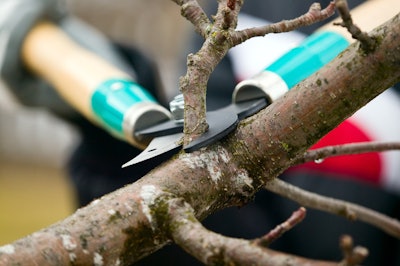
Being proactive with pruning management is necessary to help maintain the beauty, health, and longevity of your customer’s trees and shrubs.
Take a look at a few tips you can keep in mind when planning out pruning visits to your customers’ properties over the next few months.
Timing
Experts agree that winter and early spring are considered the best times for pruning most trees and shrubs. This time of the year, it’s important to prune deciduous trees because the lack of leaves will allow you to see the tree in its entirety, which lets you make the most beneficial cuts.
The University of Missouri Extension also notes that pruning in the winter minimizes wound exposure to insects and diseases, and it also minimizes the time trees begin to “heal” in the spring.
According to the North Carolina Cooperative Extension, if a plant blooms before May and is considered a spring flowering plant, it should be pruned after it blooms. Examples of these are dogwoods and azaleas.
If the plant blooms after May and is considered a summer flowering plant, it will need to be pruned before growth happens in the spring. Examples of these are crape myrtles and hydrangeas. Evergreens like boxwoods and cedars should be pruned in the dormant season between mid-November to late February.
Trees
Pruning is a beneficial practice, but it’s also important to have background knowledge on the growing habits of your customers’ trees and shrubs, as well as specific pruning techniques to avoid butchering the appearance of a tree or plant.
The University of Missouri Extension says that the best long-term tree management decision occurs at planting. Choosing the correct tree and planting it in the right place will allow the tree to grow to its natural size and form, and it may not even really need much pruning once it’s fully grown depending on the type.
Pruning yearly in the first few years after planting can often help trees become established, and it can help them develop a strong and good-looking structure.
For customers with trees that are already established, the University of Missouri Extension says the best way to plan your pruning is to study the tree’s natural architecture from a distance of 50 to 100 feet.
The first cuts should be directed towards obvious unwanted materials, any cross branches or ones that are growing towards the center of the tree and any suckers or sprouts that are growing at the tree’s trunk. Before performing the second round of cuts, take a step back and examine the tree again.
If there are any branches that look like they could one day prove hazardous, go ahead and remove them. For example, larger limbs that are growing toward your customer’s roof or power lines or lower branches that could interfere with sidewalks or traffic.
If you see trees that have more than one central leader, cut out all but the strongest to help the tree regain its normal shape and development. As a general rule, the University of Missouri Extension says it’s never a good practice to prune more than 20 percent of growth in any given year.
Shrubs
The North Carolina Cooperative Extension notes that pruning hedges and sheared plants will take a bit of forethought. Instead of pruning these plants into balls, the extension recommends leaving the plants widest at the base. This will allow the sun to reach all actively growing areas while reducing shading.
When making heading cuts on shrubs, the North Carolina Cooperative Extension recommends making the cuts inside the canopy, as this hides the cut and gives the appearance that a recently pruned plant hasn’t been touched.
If pruning narrow-leaf evergreens, be sure to make heading cuts to the origin of the lateral branch or remove the branches entirely. These plants lack the ability to produce new side branches when pruned, and if they are pruned back to no foliage, that’s what your customer will be left with.
When shrubs become overgrown, the North Carolina Cooperative Extension says the best technique to use is called severe renewal pruning or rejuvenation pruning, which is a process where shrubs are cut back to just a few inches or feet from the ground.
While the best time to perform renewal pruning is late February to early March, it can be done anytime during the dormant season. This type of pruning is beneficial but keep in mind that it is not meant for every plant in your customer’s landscape. The North Carolina Cooperative Extension says this technique should only be used on deciduous shrubs or broadleaved evergreen shrubs.












